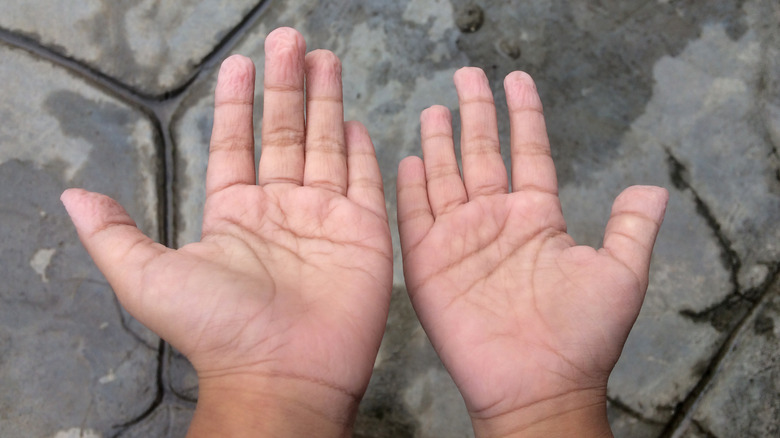The Science Behind Why Your Skin Gets Pruney In Water
At one point or another, all of us have had pruney fingers. Whether we're coming out of the bath, the pool, the ocean, or just washing the dishes, the effect of extended exposure to water on our hands and feet is the same: wrinkles.
Our intuition probably tells us that passive exposure to water is the culprit behind this phenomenon, and for a long time that was the leading scientific theory. The outermost layer of our skin (the stratum corneum) is made up of dead tissue called keratin that helps to regulate dermal hydration. It was thought that prolonged exposure to water caused the keratin to swell. Because the lower layers of skin to which the stratum corneum is affixed doesn't absorb water, the swelling causes the skin to wrinkle to compensate for the increased surface area. Even though this theory sounds plausible and is often repeated (by the likes of the Library of Congress, no less), the truth is more subtle.
What's happening?
Our understanding of the mechanism behind the wrinkling began to change in the 1930s when it was observed that a child with nerve damage to some of their fingers didn't experience the wrinkling effect in the affected digits. If the mechanism that caused pruning was caused by passive water absorption by the keratin in the skin, nerve damage shouldn't have any effect on the pruning effect. Since that wasn't the case, there must be more going on (via Mental Floss).
The precise physiology behind what is happening isn't fully understood, but the current theory, according to an article in Archives in Neurology & Neuroscience, is that water diffusing into the sweat ducts changes the balance of electrolytes in the tissues of the fingers. This triggers a sympathetic nerve response which causes the blood vessels in the fingers and toes to contract. The reduction in volume of the skin on the fingers and toes while the surface area remains the same is what ultimately causes the wrinkling.
Why is it happening?
Based on the neurological origin of the phenomenon, an article in Brain, Behavior and Evolution hypothesizes that the skin wrinkling is an evolutionary adaptation rather than an accidental byproduct of our physiology. In their paper, the authors put forward the hypothesis that these water-induced wrinkles are a sort of human rain tread.
The authors note the similarities between the shape and distribution of the wrinkles on fingers to fluvial drainage networks, such as river deltas and mountainous river systems. Such patterns, they conclude, are ideally suited to channel water away from the tips of the fingers and thus increase the friction of the skin surface to aid in grabbing wet or damp objects.
Although that's a very compelling theory, the science on the matter is still out. One 2013 study published in Biology Letters found that skin wrinkling increased manual dexterity handling wet objects when compared to unwrinkled skin. But a 2014 study published in PLoS ONE found the exact opposite. In other words, we still don't know why our skin wrinkles when it's wet.

